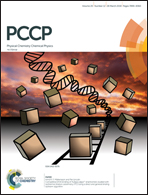The role of unique spatial structure in the volume phase transition behavior of poly(N-isopropylacrylamide)-based interpenetrating polymer network microgels including a thermosensitive poly(ionic liquid)†
Abstract
Well-defined poly(N-isopropylacrylamide)/poly(tributylhexylphosphonium 3-sulfopropylmethacrylate) (PNIPAM/P[P4,4,4,6][MC3S]) interpenetrating polymer network (IPN) microgels were synthesized by two-step precipitation polymerization, and the thermally induced phase transition mechanism of IPN microgels was investigated using dynamic light scattering (DLS), temperature-dependent IR spectroscopy together with the perturbation correlation moving window (PCMW) technique and two dimensional correlation spectroscopy (2Dcos). For comparison, PNIPAM/P[P4,4,4,6][MC3S] polymer mixture was also studied to reveal the influence of the complex spatial network of IPN on the thermoresponsive behavior. Due to the strong hydrophilic feature of P[P4,4,4,6][MC3S] and the special IPN structure, PNIPAM and P[P4,4,4,6][MC3S] moieties exhibited different phase transition tendencies during heating. In detail, the dehydration behavior of the PNIPAM part seemed gradual and continuous, whereas that of ester C![[double bond, length as m-dash]](https://www.rsc.org/images/entities/char_e001.gif) O in the P[P4,4,4,6][MC3S] part became sharp. The two components dehydrated independently and successively in the polymer mixture without any mutual interaction. The collapse of the P[P4,4,4,6][MC3S] network at the second transition stage increased the amount of intramolecular hydrogen bonding (amide C
O in the P[P4,4,4,6][MC3S] part became sharp. The two components dehydrated independently and successively in the polymer mixture without any mutual interaction. The collapse of the P[P4,4,4,6][MC3S] network at the second transition stage increased the amount of intramolecular hydrogen bonding (amide C![[double bond, length as m-dash]](https://www.rsc.org/images/entities/char_e001.gif) O⋯D–N) in the PNIPAM moiety. Additionally, the electrostatic interaction in the P[P4,4,4,6][MC3S] network played a non-ignorable role in enhancing the swelling property of PNIPAM/P[P4,4,4,6][MC3S] IPN microgels.
O⋯D–N) in the PNIPAM moiety. Additionally, the electrostatic interaction in the P[P4,4,4,6][MC3S] network played a non-ignorable role in enhancing the swelling property of PNIPAM/P[P4,4,4,6][MC3S] IPN microgels.



 Please wait while we load your content...
Please wait while we load your content...